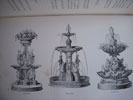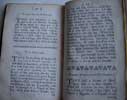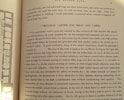Grand Livre des Patissiers et des Confiseurs
PAR URBAIN-DUBOIS AUTEUR DE LA CUISINE ARTISTIQUE, DE LA CUISINE DE TOUS LES PAYS, DE LE CUISINE CLASSIQUE OUVERAGE EN DEUX PARTIES RENFERMENT CENT TRENTE-HUIT PLANCHES GRAVES Premier partie: 38 Panches PARIS LIBRAIRE E.DENTU, GALERIE D'ORLEANS, PALAIS-ROYAL ET DANS TOUTES LES GRANDES LIBRAIRIES 1883 Droites de tradnction [sic] et de reproduction reserves.
FIRST EDITION. 1883. 2 Volumes in one. Very thick 4to. 310x240x70mm. Marbled front paste-down. 1st Volume: 1fep. Half title. [1] Title Page. Verso with Dubois's facsimile signature. (1)viii Preface dated 1882. (1)x-xxiv La Patisserie with a double page engraving of a Grand Buffet de Bal. 1-338. 4 Full page plates with each verso blank. (1)b-i Table Alphabetique. [1] With 38 Planches. 2nd Volume: (1)350-698. (1)700-701 Table Alphabetique. [1] 1fep. [1] Back endpaper and paste-down marbled. With 100 Planches. With wonderful conditioned dark blue pebbled cloth boards and dark blue 1/2 morocco spine with raised bands and blind tooling, and with gilt lettering. Internally very clean with very mild foxing on occasion. A very good copy of a very scarce book.
- Urbain Dubois, born 1818 at Trets, Provence, died in 1901. This is the one of the scarcest of Dubois' books. It is a monumental work with the same striking visual impact as two of Dubois' other works -- 'La Cuisine Classique' 1856, and 'La Cuisine Artistique' 1870. The 138 plates of highly elaborate centerpieces of the Patissier's craft, some with armature designs for the structures of the desserts, and also with recipes for each dish, amaze and delight the reader. Research of documentation reveals that these labour intensive and time consuming centerpieces also graced the tables of Versailles, as early as the 17th century. A two volume set was also published and sold in the same year - 1883. It has exactly the same content and page collation, the only difference being the separate title page for the 2nd volume. This very scarce two volume - single book, is a handsome, thick and heavy tome. It is by far the hardest of Dubois' books to find. It is much sought after and commands very high prices at auction. Bitting p131, 2 volumes. Vicaire p291, 2 volumes. BL has one copy of 1895. Not in Cagle.






click on image to enlarge

Antiquarian category
ref number:
11074 








































